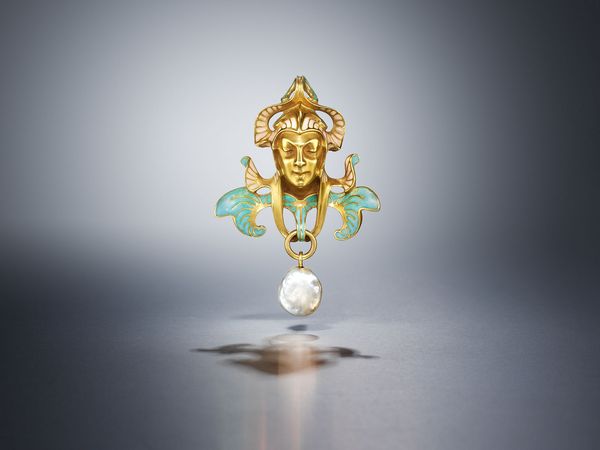René Lalique, Art Nouveau Enamel and Pearl Pendant, circa 1896. The New York Jewels Auction.
The New York Jewels Auction on 12 June features an outstanding example of work by master jeweler René Lalique (1860–1945).
The French jeweler and glass designer René Lalique is legendary for his contributions to the Art Nouveau movement. In retrospect, we can see that his artistic innovations and rigorous technical skill revitalized jewelry making at a time when the mass production of goods was spoiling artistic crafts and the survival of jewelry making as an art form hung in the balance. His stature today is a testament to his enduring legacy.
Art Nouveau lasted only a short time, from about 1895 to 1910. The movement’s jewels, inspired by the discovery of Japanese art and emphasizing natural forms, were highly decorative. Jewels were often made with visually striking materials such as opal, enamel, and moonstone — lesser known for their intrinsic value — were a reaction against the mass-produced, overwrought designs of that era.
Lalique honed his skills at a very young age. After the death of his father in 1876, he began working as an apprentice to leading Parisian jeweler and goldsmith Louis Aucoc, learning the arts of stone-setting and goldsmithing from the studio’s master jewelers. In that same year, he enrolled at the L’Ecole des Arts Decoratifs in Paris, where he stayed until 1878, and then the School of Art at Sydenham in London. By 1881, he returned to Paris and broke out on his own to begin manufacturing jewelry for several French firms, including Boucheron, Vever, and Cartier.
René Lalique is championed as a disruptor of early 20th century design who broke with the classic way of jewelry making. Pursuing beauty with unparalleled technical finesse, he developed a language of fluid lines, asymmetrical forms, dramatic sizes, and a sense of movement and dynamism that made them both modern and timeless.
Especially notable is Lalique’s mastery of the art of enameling, which is so synonymous with the Art Nouveau movement. In his plique à jour technique — which loosely translates as “letting in daylight,” he masterfully applied enamel in cells with no backing, allowing the light to shine through for an effect similar to what we see in a stained-glass window.
Here, we see René Lalique's Art Nouveau Enamel and Pearl Pendant, circa 1896 held aloft by a model, for scale.
He further combined his innovative use of materials such as horn, pearls, ivory, and glass with his pioneering techniques in lost-wax casting to create delicate forms previously unattainable in jewelry making — including the flowers, leaves, animals, insects, and human figures he expressed with such exquisite precision.
Among Lalique’s most notable works is his “Dragonfly Woman” corsage ornament, a fantastic creature, famously made for and worn by the French actress Sarah Bernhardt. This imaginative jewel was later exhibited at the Paris Universal Exhibition in 1900 and established Lalique as a visionary jewelry artist on an international scale. In that same year, he was named Officer of the French Legion d’Honneur. He would go on to create many new forms and techniques through the years, including revolutionary advances in glass making that led to 16 patents.
René Lalique passed away on 1 May 1945, in Paris. His son Marc then led the business — and later his granddaughter Marie-Claude — to carry his legacy over the next several decades. In 2018, the company proudly celebrated 130 years in business.
René Lalique was a visionary artist whose creations transcend the boundaries of traditional jewelry design. His contributions leave an indelible mark on the world of art and design that continues to captivate us today.

